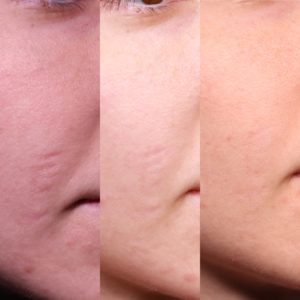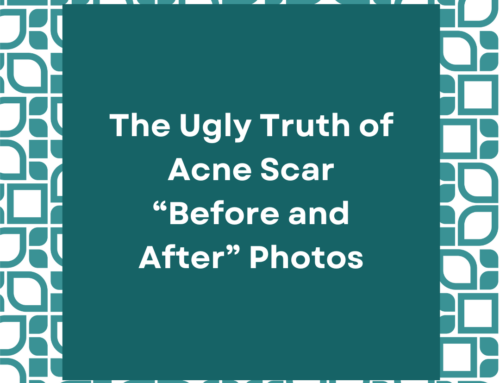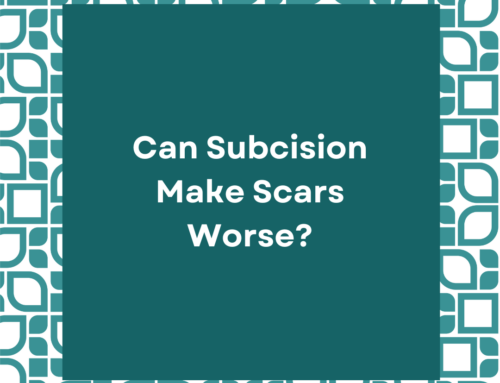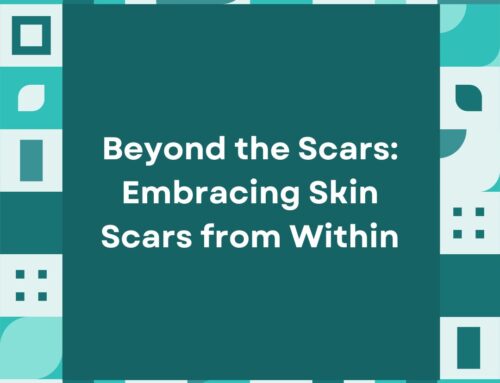Acne-born scars are too stubborn to be removed, and many of us face them every other day. Treating and curing these scars comes with several “hit and miss” methods, which, of course, fail to satisfy most of the time. But what if we tell you we have another solution to your problem?
Subcision!
The term “Subcision” refers to a minor outpatient surgical procedure that can be used to repair acne scars and doesn’t require an incision under the skin.
Are you curious to know if Subcision is the right treatment for you and whether it removes the appearance of the scars? In this guide, we have brought the details of everything you need to know about Subcision.
Stay tuned and keep reading!
What is Subcision?
Subcision scar treatment is a minor incision-less surgical procedure intended to treat some specific scars, wrinkles, and cellulite. The process is also known as Subcutaneous Incisional Surgery.

It’s a complete incision-free procedure that involves inserting a hypodermic needle by a dermatologist into your skin beneath the scar. The fibers tying the scar to the tissue below are broken and made free with the needle. The treatment helps in releasing collagen at the needle insertion site on top of lifting the depressed scar.
To be more specific, Subcision disintegrates the tissue bands pulling the scarred area down causing skin depression. It, therefore, allows the formation of new, healthier tissues
To obtain the desired effects, this minimally invasive surgery frequently necessitates numerous procedures. The exact number of skin Subcision treatments needed is entirely patient dependent, however, you should expect more than 2 treatments for the best results.
When it comes to safety, Subcision is an apparently safe procedure if done in a sterile environment by an experienced medical professional. If it’s not done properly, Subcision can usher fatal impacts and may also give rise to new scars.
Over the last few years, this scar healing technique has gained enormous popularity in the USA and more and more people are deciding to improve their skin texture by reducing the visibility of the scars through Subcision.
How Does It Help in Reducing the Appearance of Acne Scars?
Subcision helps to relax the fibrous filaments that are holding the scar tissue downwards and to encourage the development of new collagen. This helps to enhance the overall look of depressed or rolling scars.
A specific hypodermic needle is used for Subcision Scar Treatment and introduced through an incision on the skin’s surface. Instead of using a hypodermic needle for Subcision scars, the professional can use a Cannula, Nokor Needle, or a Taylor Liberator depending on the type of the scar.
The needle’s sharp edge is used to cut the fibrous threads holding the scar to the underlying tissue. This procedure encourages the release of collagen at the location of the surgical intervention in addition to helping to raise a depressed scar. Both the release of collagen and the lifting of the scar lower its visibility.
After 2 months, the visible results of the procedure start to be permanent. For the best result, you may need several sessions and a combination of other treatments including collagen-stimulating fillers, lasers, dermabrasion, chemical peels, and topical retinoids.
Types Of Scars Subcision Is Mostly Effective For
Scars on the face can make a person feel uncomfortable; especially acne scars or chickenpox scars that leave permanent marks on the skin. Nowadays there are treatments for scars – thanks to the Subcision treatment. However, not every type of scar is cured by this procedure.
While Subcision can treat scars pretty well, it’s a safe and easy method also. It is found to be the most successful in treating acne scars as well as reducing some other types of scars elaborated below:
1. Depressed Bound Down Scars
Subcision is found to be super effective for the Depressed Bound Down scars caused due to Chickenpox, acne, varicella, surgery, and trauma. These scars sit under the skin surface, and have a pitted or sunken appearance.
2. Depressed Distensile Scars
To get rid of the Depressed Distensile Scars formed on the skin after surgery, trauma, or acne, heals, Subcision treatment is the best remedy out there. These can be stubborn and way too difficult to remove. Hence, dermatologists often recommend other treatments like Dermabrasion, or Chemical Peels with Subcision to lessen the distensible scars.
3. Depressed Skin Grafts
Skin grafting is a medical operation in which skin is taken from one part of the body and transferred to another part of the body. Often, scar tissue builds up around the graft side causing depressed skin graft scars and Subcision can effectively help with that.
4. Cellulite
Subcision is a trusted treatment for cellulite. It treats Septa, the very basic structural cause of Dimpling. Under this procedure, the Septa is severed by a tiny blade that disperses the subcutaneous fat under the skin’s surface more uniformly. The treated skin then smoothens itself out within approximately 3 days just like a rubber band.
5. Wrinkles
Wrinkles are common signs of aging which makes fine lines appear on the uppermost layer of the skin. But you can pause the aging of the skin through Subcision Treatment.
In the procedure of Wrinkle Subcision, a specially designed Cannula moves safely through the wrinkle tissues. The fibrotic strands are released pulling the skin down. Dermal fillers are sometimes prescribed by cosmetic physicians to provide sufficient healing conditions.
However, not all forms of scars respond well to Subcision. For example, this procedure might not be effective in treating Hypertrophic scars or Keloid scars. Furthermore, patients, who are under systematic oral retinoid, who have blood clotting or bleeding disorders, and who are suffering from an active viral or bacterial infection should not undergo a Subcision treatment.
What Are The Benefits Of Subcision?
Subcision is a helpful treatment for people having scars on the skin caused by acne, trauma, chickenpox, and surgery. In addition, if someone has wrinkles and cellulite marks on the skin, this treatment can also help to diminish their appearance.
Its benefits tie back to the healing of acne scarring. Many patients after trying Hyaluronic Acid-Based dermal filler often turn to Subcision to cure depressed acne scars like rolling scars as well as Boxcar scars. Here is a list of the key benefits of the Subcision procedure:
1. It Lowers The Scar Tissue
With the help of Subcision, the underlying tissues are separated from the scars thereby lessening the scar tissues. This can prevent the new scars from forming because of the surrounding acne and technically stops the skin while it is ahead.
2. Improves The Appearance Of The Skin
The Depressed Scars or Rolling Scars Subcision procedure is the best remedy for wrinkled, scarred skin. These conditions once developed on the skin affect the quality which in turn gives rise to further permanent complications. A minor surgical procedure like Subcision corrects these imperfections and improves the skin’s appearance.
3. It Improves Skin Texture
Depressed scars, fine lines, cellulite, and wrinkles degrade the skin texture to a considerable extent. When the acne scars are released from the below-lying tissues, the skin rises and stretches giving a smoother texture.
4. It Promotes The Production Of New Collagen
The dermatologist puts a needle under your skin and moves it in multiple directions to separate the upper layer of the skin from the scar tissue underneath. This initiates the healing process that forms collagen to push the depressed scars up.
What To Expect With The Subcision?
It’s true that Subcision is a clinically safe and feasible scar treatment procedure although; there are a few crucial points that need to be remembered before going through it. It’s always better to be clear about the things you can expect from this treatment so that you don’t get disappointed by setting any non-achievable expectations. Take a look at the points below:
1.It’s An Outpatient Procedure
Generally, Subcision treatment is carried out in a dermatology clinic or office. It’s typically performed as an outpatient procedure, so you won’t need to be admitted to the hospital once it’s finished. You can wrap up the first session of your Subcision treatment regime within a day itself.
2. Use Of Specialized Needle
The Subcision procedure involves the use of a specially designed hypodermic needle beneath the scar, into your skin. It’s then moved from side to side to release the scar from the underlying tissue. You may hear a soft crackling sound during the breakage of the skin fibers. Apart from the Hypodermic Needles, Nokor needles or Tri-Bevelled needles (Number 18 or 20 gauge), and Cannula are used.
3. Fades The Scars
This process won’t just disappear your acne scars completely. The treatment can lessen the depression of the scars to reduce the shadowing of the skin. So don’t expect the scars to heal completely but there will be a significant improvement in their appearance.
4. After Care
Cold compresses are administered after the surgery to aid with bleeding and irritation reduction. Following the operation, laser resurfacing or filler therapy is frequently used to further enhance the scars.
5. Side Effects
You will experience bruising and swelling at the site of the Subcision along with some lesser common after-effects such as skin discoloration, an infection around the injected area, and injury to blood vessels or nerves around the scar.
How To Prepare For Subcision?
Before undergoing a Subcision, it’s essential to consult a dermatologist as he/she will examine your scar condition and other health conditions thoroughly prior to making you ready for the surgery.
Especially, if you are on oral acne medications such as Accutane, or intaking any blood thinner, you have to consult with a professional beforehand. It’s better to avoid blood thinners and other anti-inflammatory, non-steroidal drugs for 2 weeks before the procedure. Your dermatologist will guide you further in these aspects.
The expert after a thorough examination of your scars will cleanse your skin thoroughly with a disinfectant as a needle will be inserted into your skin. So, any existing break on the skin can lead to a major skin infection.
The dermatologist himself/herself or the assistant will sterilize the needle to kill the presence of any microorganisms on it and prevent the infection. Performing Subcision on the skin having active breakouts or active infection can be dangerous and may create long-term negative impacts.
Brief Overview Of The Subcision Procedure
Subcision is a cosmetic procedure that breaks and releases the scars that have stuck too deeper into the underlying tissues and bound down. Under the supervision of trained medical professionals, it’s carried out in a sterile environment. Here is a breakdown of how the Subcision procedure is carried out by the dermatologists at the clinic:
- Step 1- The Subcision Scar Treatment, topical or infiltration is carried out under local anesthesia. To remove the fibrous bands at the dermal or deep dermal subcutaneous layer, a specialized 18 to 20-gauge needle is introduced beside the scar into the deep dermis having the bevel upwards. In some cases, Subcision needle size between 25-to-27-gauge needles is also used by the experts.
- Step 2- It’s then moved to and fro under the scar in a fan-like motion after which the needle is withdrawn and compressed circularly around the exit point to remove extra blood and stop the creation of big hematomas. It’s permitted for a little hematoma to develop, supporting the scar that has been discharged.
- Step 3- Immediately after the Subcision is done, pressure is applied to the wound manually for several minutes. In addition to pressure, the application of ice to the operated site is common to prevent hemostasis and reduce the likelihood of bleeding.
When treating regions with a propensity for a hypertrophic reaction following Subcision, in particular, the number of Subcision should be restricted during the initial treatment to evaluate the patient’s response.
Can You See The Subcision Before And After Differences?
You can easily determine the Subcision before and after differences on your skin. While the scars will not just vanish overnight after the treatment, they will start to fade if proper aftercare is followed. You may experience some bruises, puffiness, redness, and pain in and around the treatment site but with proper medication these conditions will get healed within 2 weeks.
Your skin will start getting a smoother texture with a noticeable reduction in the fine lines, scar marks, and dark spots after a few more weeks or most probably months. Subcision filler permanent treatment, on the other hand, can stop the re-anchoring of the skin, and the before/after differences will be widely visible.
What Are The Side Effects Of Subcision Scar Treatment?
Subcision treatment has side effects although they are very minimal in nature. In addition, if a proper aftercare regime is followed, then these aftereffects can be overcome quickly. Below is a list of the possible side effects, you are likely to experience after a Face Subcision:
1. Infection
The Subcision procedure does entail a needle penetrating the skin, thus if it is not carried out in a sterile environment by a medical expert, there is a risk of infection.
2. Hyperpigmentation
Depending on the patient’s recovery process, more scars from the Subcision may develop. Careful aftercare is important since there is a high chance of occurring temporary post-inflammatory hyperpigmentation.
3. Bleeding And Swelling
It’s important to be tolerant and nice to the skin throughout this procedure because you may bleed, bruise, or experience swelling at the injection site, and recovery might take several days.
4. Soreness
The patient may also feel pain in and around the area after the treatment and a cold compress helps to alleviate it.
5. Hypertrophic And Keloid Scars
Hypertrophic or Keloid scars may occur after an incorrect Subcision procedure although it’s very unlikely. If you develop a hematoma, chances are that more scarring would happen.
6. Skin Discoloration
Furthermore, the sun-exposure is strictly prohibited for at least three weeks as it can aggravate permanent skin discoloration.
How To Prepare For Subcision?
Before you schedule the Subcision procedure, it’s important to consult a dermatologist first. Especially, if you are on oral acne medications such as Accutane, or intaking any blood thinner, you have to consult with a professional beforehand. It’s because, before undergoing this treatment, you should not be on such medications.
The expert after a thorough examination of your scars will cleanse your skin thoroughly with a disinfectant as a needle will be inserted into your skin. So, any existing break on the skin can lead to a major skin infection. The dermatologist himself/herself or the assistant will sterilize the needle to kill the presence of any microorganisms on it and prevent the infection.
What Are The Side Effects Of Subcision Scar Treatment?
The Subcision procedure does entail a needle penetrating the skin, thus if it is not carried out in a sterile environment by a medical expert, there is a risk of infection. Depending on the patient’s recovery process, more scars from the Subcision may develop. Careful aftercare is important since infections and hyperpigmentation can both occur.
It’s important to be tolerant and nice to the skin throughout this procedure because you may bleed, bruise, or experience swelling at the injection site, and recovery might take several days. The patient may also feel pain in and around the area after the treatment and a cold compress helps to alleviate it. Furthermore, the sun-exposure is strictly prohibited for at least three weeks as it can aggravate permanent skin discoloration.
Things To Consider Before Going For Subcision Treatment
1. Places Of The Body Where Subcision Treatment Is Performed?
Typically, Subcision is carried out by cosmetic experts in places like Forehead, Cheek, Temples, and Marionette Region. It’s because mainly the depressed scars are developed in and around these regions where acne brings unwelcomed pimples, redness, blackheads and whiteheads. Under the expertise of a trained, experienced professional, the Subcision Treatment is carried out at a dermatological clinic or office.
It’s an outpatient procedure where you don’t have to get admitted to a hospital once the procedure is over. Furthermore, your dermatologist will explain the steps to you before undergoing the procedure.
2. Ways By Which Subcision Treatment Can Benefit You
To repair acne scars, a small office procedure called Subcision is performed. It entails pricking your skin with a tiny needle to separate the acne scar from the deeper tissues. This enables your skin to tighten and lessen the visibility of the acne scar.
The only surgery that can lift scars that have been tethered down is Subcision. This makes rolling and boxcar acne scars better. The amount of improvement may be between 10% and 50%. Apart from these, Subcision is a safe treatment for all types of skin and all types of scar. It resolves deep scarring and pitted marks on the skin which is less harsh than the traditional methods.
However, here is one vital point that you will have to remember. The fundamental idea behind Subcision is not to vanish the scars. The key objective of this treatment is to reduce the appearance of the acne scars and make them less visible on the skin.
3. Treatment Frequency, Results, And Downtime Of The Subcision Treatment
-
Treatment Frequency
Multiple Subcision procedures are advised for optimal outcomes. Most patients will need 3 to 6 treatments, depending on the level of scarring and each person’s recovery process. At least four weeks have passed before additional operations can be carried out.
-
Results
After the successful completion of the procedure, you can expect to see the results within a few weeks. In some cases, the results start becoming prominent after few months accompanied by proper medication and skincare regime.
-
Downtime
After the procedure, patients can have some moderate edemas or bruising. However, Subcision often results in minimal downtime. The average time for the skin to fully recover following Subcision surgery is one week.
4. Subcision Before And After Differences
The Subcision before and after differences are clearly visible as this procedure causes drastic changes to your skin. Not only the visibility and depth of the scars will lower but also quality and texture of the skin will be improved to a great extent.
Although there will be soreness, redness, and swelling in and around the treatment site, these conditions will heal with the medications prescribed by the dermatologist who performed the procedure.
You can expect a numb sensation during the Subcision treatment because of the Anesthetic applied. After the Subcision treatment, you will feel numbness in and around your treatment area till the effects of Anesthesia last.
5. Subcision Does Not Provide Permanent Results
There are a range of ongoing confusions and myths regarding the effectiveness of the acne scars. There is no doubt that Subcision is a super consistent acne scar treatment. However, when it comes to permanence, the long-term effectiveness of the Subcision acne scar treatment depends on the anchoring of the skin.
Because the region heals back together and shrinks again after Subcision, it can’t be considered to be permanent. However, fat transfer coupled with Subcision produces greater results than either procedure by itself.
6. People With Specific Types Of Scars Are Only Suitable For Subcision
Not every patient with any type of scars is supposed to go through Subcision. This procedure works best for people having acne scars, scars caused by chicken pox, surgeries, and wounds. For the patients having Keloid scars, Hypertrophic scars or Ice pick scars, Subcision is not at all a suitable treatment. In addition, the treatment doesn’t work for Pigmented or Red Acne scars.
On the other hand, people having existing viral infections in their body, or blood clotting disorders should never undergo this procedure as it will produce fatal results for them. If you are on any blood thinner, do not ever go for Subcision scar treatment without informing your dermatologist in detail.
How Long Does It Take To Heal?
It usually takes 1 to 2 weeks for the pain, bruising, and swelling to go down. To aid you with the Subcision healing process, your dermatologist can recommend an antibiotic or anti-inflammatory medicine.
The extent of the scar and your body’s capacity to produce the scar tissue will determine how many therapy sessions you’ll require. Several months may pass until the scar is no longer noticeable.
How Much Does Subcision Cost?
The Subcision cost may vary from one patient to another. Several factors determine the cost of this treatment, such as the severity of the scars, the number of sittings required, the size of the affected area, the clinic you choose, etc. It’s the dermatologist who will examine your skin condition first and then give you an estimate of the cost.
In case you have private health insurance done, and wondering whether the cost of the Subcision treatment will be covered under this, here is an important fact you need to know – it may cover the cost and may not as well. This depends on the terms and conditions laid out by your insurance company.
In some cases, even if it takes this procedure into account as “medically necessary,” you may need to pay for a specific portion of the procedure. Overall, the cost structure of a Subcision treatment is different for different service providers.
What Is Cannula Subcision?
A cannula is a tiny tube that medical professionals place into a patient’s vein or bodily cavity, such as their nose. They are used by doctors to drain fluid, give medicine, break fibrous bonds in the underlying skin, or deliver oxygen.
Small regions that require Subcision work best when done with a cannula. In a Cannula Subcision treatment, with the use of a needle, a tiny hole is created in the skin. Just below the skin, a cannula is inserted into the hole. The scar tissue bands that are dragging the scar down are divided using a cannula.
How Many Times Do You Need To Undergo Skin Subcision Treatment?
To be very specific, the frequency of a skin Subcision treatment entirely depends on the examination of the dermatologist. Factors such as depth and severity of the scar, skin health of the patient, and existing medications largely govern the number of times one needs to undergo a face Subcision treatment.
So, if you want to know whether you need another Subcision after one session, it’s your dermatologist who can give the accurate answer. For the greatest outcomes, 3 to 6 therapy sessions are often prescribed by the skin experts
Subcision can be performed in conjunction with other skin treatments like micro-needling or laser resurfacing to boost the efficiency of each technique. In that case, the duration of the entire treatment will extend a bit longer.
Can Subcision Be Carried Out While On Roaccutane (Isotretinoin)?
It’s always been a question whether Subcision can be carried out while on Roaccutane (Isotretinoin) Treatment. There has been a range of myths about this. However proving all those wrong, the latest recommendations say that minor surgical procedures, including Subcision, can be carried out both while a person is still on Accutane and most definitely very soon after it has been stopped.
Needless to mention that it’s safe only when the patient is on a low dose of the same. So, if you are on the low dosage of Roaccutane (Isotretinoin), it’s safe to go for a Subcision provided that you have already consulted with your dermatologist regarding this.
Treatments Combined With Subcision
It’s good news for you that the Subcision for wrinkles or scars is flexible enough which means it can be paired with some other scar or face scar healing treatments. Nevertheless, each of such treatments needs to be performed in a medical setting by a professional dermatologist, This includes:
1. Topical Retinoids
Subcision is completely safe with low dosages of Topical Retinoids like Isotretinoin. These are doctor-prescribed creams containing the goodness of Vitamin A that can help in smoothening out the appearance of scars.
2. Microneedling
Subcision and Microneedling can go hand in hand. The later can be conducted within 1 day of performing Subcision on the skin. This is also an in-office procedure using tiny needles to boost collagen production in the skin. Tools such as Dermaroller and Dermapen are used by dermatologists to do Microneedling on the skin.
3. Acid Peels/Chemical Peels
After Subcision, you can apply Acid Peels; for example, 15% of caustic peels such as Trichloroacetic Acid peels (TCA) every 4 weeks. It suits most types of acne scars. Achieving mid-depth peeling is crucial when treating acne scars with a full face peel. Chemical peels like this improve scarring by eroding the topmost layer of the skin.
4. Fractional Laser Treatment
Fractional Laser Treatment along with Subcision is also known as Subcision Laser Treatment. It’s also a safe and minimally invasive scar healing procedure. In order to remove the top layer of skin and repair scarring, this procedure uses lasers.
5. Dermabrasion
Dermabrasion is recommended alongside Subcision to help with the acne scars. This technique includes the use of a wire brush to exfoliate the uppermost layer of the skin. Nonetheless, the procedure is effective on the shallow scars only and not on the deeper, serious scars.
Can Subcision Be Done At Home?
The simplest answer is NO. Although Subcision is a safe surgical intervention, it should never be tried at home on your own. Especially, when it comes to Deep Subcision, the procedures involved consist of steps that need to be carried out by specialized professionals with years and years of training and experience.
Doing it alone at home may cause severe permanent harm to your skin that might not be cured. In addition, there are several steps required to perform before and after Subcision such as prepping the skin or cleaning the treated area which can be done effectively and safely by a dermatologist only. Hence, it’s always advised to get it done by a dermatologist having extensive experience in doing Subcision.
Conclusion
To lessen the visibility of various types of scars, Subcision is a reliable outpatient surgery without the risks of any side effects. Subcision for Chicken Pox Scars, acne scars, wrinkles, and boxcar scars are pretty common and effective as well. It’s crucial to remember that Subcision for Ice Pick scars, Keloid scars, and Hypertrophic scars is not going to work. Thus, before booking a Subcision session, carefully go through the prerequisites otherwise the treatment may go into vain or give adverse effects.
Scar Healing Institute provides the best Subcision scar treatment in the USA conducted under the responsibility of experienced dermatologists. Visit us today and talk to one of our experts in case you have further queries.
Frequently Asked Questions
1. How Can I Tell If I Need Subcision?
If you have several rolling or box scars, or depressed acne scars that do not fade with skin stretching or vanish when you smile, you need a Subcision treatment to improve your appearance. Lessening the scar tissues can prevent new scars from forming because of the surrounding acne.
2. How Many Times Does Subcision Need To Be Carried Out?
Typically, this process is done 3 to 6 times, with a minimum of 4 weeks between each session depending on the doctor’s recommendation. This may vary based on the severity and intensity of your scars.
3. What Is The Downtime After Subcision?
After a Subcision operation, most patients require 7 to 10 days of recuperation although it depends from one patient to another. During this period, swelling and bruising will go away; ice packs will help. The majority of applicants resume their regular activities right away following the surgery.
4. How Long Does It Take To See Subcision Results?
Sometimes the effects of Subcision are seen right away. Usually, the anesthetic causes quite a bit of edema and it can take a day or two for this to settle. Most people notice the benefits in between 1 and 3 months.
5. Is Subcision Surgery Better Than Microneedling?
Although Microneedling is incredibly good at treating fine wrinkles, hypopigmentation, and surface scars, Subcision surgery is found to be more effective at treating deeper scars like box-car acne scars. Both of them are two feasible options for different reasons.
6. Are Subcision Results Permanent?
Treatment for acne scars by Subcision has rather long-lasting effects. The procedure relieves the skin from its smoothing and anchoring. The treatment’s outcomes will be practically irreversible if the anchoring does not recur right away or throughout the recovery phase.
7. How Much Can Subcision Improve?
Scars that have been tied down can only be lifted via Subcision. As a result, it lessens the acne scars from rolling and boxcars. The percentage of improvement may range from 10% to 50%.
8. Does Subcision Work Without Fillers?
Subcision surgery is unquestionably effective without fillers. It has the potential to be more successful than lasers in treating some forms of deep atrophic breakouts that are attached to the underlying muscle layer.
9. What You Should Not Do After Subcision?
After you have undergone the Subcision procedure, do not touch the treated areas with your fingers except while washing them for the first 24 hours. Touching the treatment areas with unclean hands may lead to infection. If you have done Subcision on your face, you can resume the normal shower or washing activities after 8-12 hours if not instructed differently by your dermatologist.
Schedule an Appointment
Scar Healing Institute
Scar Healing Institute is committed to developing the most effective treatments for scarring. Our team of scar revision specialists are continually inventing the latest technologies and formulas to deliver the best results for our patients.




